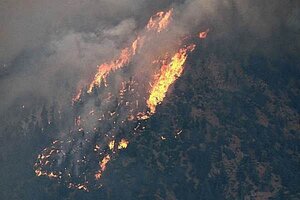Monster wildfire rages in Colorado
Thousands flee homes as western wildfires persist. Utah's Governor Gary Herbert estimates the fire has caused millions of dollars worth of damage. Soot and smoke also worry residents.

Two lines of fire move across a hillside above a subdivision in the Waldo Canyon fire, west of Colorado Springs. A monster Colorado wildfire took a turn for the worse as hot winds pushed flames north, prompting the evacuation of 7,000 more people, officials said.
REUTERS/Rick Wilking
COLORADO SPRINGS
A monster Colorado wildfire raging near some of the most visited tourist areas in the state took a turn for the worse on Tuesday as hot winds pushed flames north, prompting the evacuation of 7,000 more people, officials said.
Colorado's so-called Waldo Canyon fire sent a mushroom cloud of smoke nearly 20,000 feet (6,100 metres) into the air over Colorado Springs near Pikes Peak, whose breathtaking vistas from the summit helped inspire the song "America the Beautiful".
Closer to the blaze, which has been fanned by winds blowing into the Southern Rockies from the prairies to the east, trees were visibly twisting from the heat of the flames.
The latest evacuations brought the total number of people forced from their homes to about 12,000 as the blaze posed a renewed threat to hundreds of dwellings and appeared to have roared to within about a mile (1.6 km) of the U.S. Air Force Academy grounds in Colorado Springs.
Operators of a famous cog railway that carries tourists up to Pikes Peak said the trains would remain shut down on Tuesday for a third straight day.
The highway that leads up to Pikes Peak has been closed since shortly after the fire erupted on Saturday, as has the popular Garden of the Gods, a picturesque park of tall, rocky spires and oddly balanced boulders.
Air tankers dropped fire retardant in the blaze's path to slow its advance, while firefighters on the ground battled to protect homes along a highway at the mountain's edge, including the upscale, gated community of Cedar Heights. No homes were reported burned, but the fire consumed a wooden tent platform.
"We're feeling pretty good that's the only thing we've lost given this monster we are dealing with," said Rob Deyerberg, a fire information officer.
The closures around Pikes Peak, billed as the world's second-most visited mountain after Japan's Mount Fuji, have drawn attention to the fire's negative impact on the tourism industry just at the start of the peak summer travel season.
After three days, the blaze has scorched an estimated 4,500 acres (1,821 hectares), and fire crews managed to carve containment lines around just 5 percent of its perimeter. The cause was still under investigation.
A recreation area belonging to the Air Force Academy was ordered evacuated due to its proximity to the fire, and all trails leading west of the school were closed, the base said.
'Trying to Remain Optimistic'
Despite the fresh evacuations, the town of Manitou Springs, which had been evacuated over the weekend, appeared to remain out of imminent danger after residents were allowed back on Sunday.
Pam Staley, 60, a Colorado Springs resident, said she was concerned about the health effects of thick smoke and soot on many of her elderly neighbors who live in older homes without air conditioning.
"They sleep with open windows, and when the wind shifts, in the middle of the night, they get sick," she said as she stood watching the blaze from a safe distance at a local high school. Their eyes are watering, they're coughing. I'm really, really worried about them."
The wildfire was one of about a dozen burning out of control around Colorado, including the much larger High Park Fire near Fort Collins, a university town north of Denver close to the Wyoming border.
"We're going to be continuing to have to deal with these fires for weeks to come," U.S. Forest Service Chief Tom Tidwell said. "We anticipate it's going to be a long fire season."
To the east of the Waldo Canyon blaze, a fast-moving prairie fire apparently sparked by a blowout on a passing vehicle torched 45,000 acres (18,210 hectares) of grassland and ripped through the town of Last Chance, population 25.
The blaze destroyed 11 buildings including four homes before being contained.
The High Park Fire - the state's second-largest blaze on record and its most destructive ever - has consumed 87,250 acres (35,308 hectares) in steep canyons since it was sparked by lightning two weeks ago. It is blamed for the death of a 62-year-old woman in her cabin and has destroyed 248 homes.
An estimated 4,300 people remain evacuated from their homes as that fire burns through grass, brush and Ponderosa pine.
In southwestern Colorado, the Weber Fire grew to 8,930 acres (3,615 ha) but firefighters held it back from the small town of Mancos, east of Mesa Verde National Park. Roughly 50 homes were evacuated, officials said.
Farther to the west, authorities said a body was found in the ashes of a house charred by Utah's fast-moving Wood Hollow Fire, marking the first fatality in a blaze that already has scorched more than 39,000 acres (15,780 ha). Fresh evacuations were ordered there on Tuesday.
The Wood Hollow blaze had already burned an estimated 30 homes and killed 75 sheep between the rural communities of Fountain Green and Indianola.
Governor Gary Herbert, who toured the fire by helicopter on Monday, estimated the property losses so far at $7 million. No injuries have been reported, but Herbert said fire officials did use a helicopter to rescue some shepherds from the fire's path.
(Additional reporting by Ellen Miller in Grand Junction, and Jennifer Dobner in Salt Lake City Editing by Cynthia Johnston and Eric Walsh)
[Editor's note: The subhead to an earlier version of this story gave the wrong state of which Gary Herbert is governor. Mr. Herbert is governor of Utah.]

